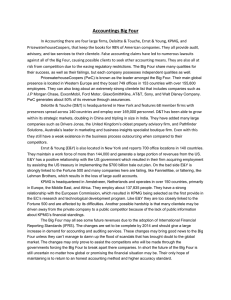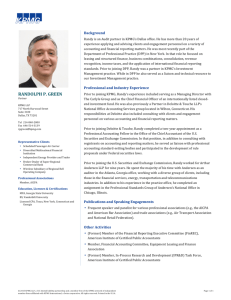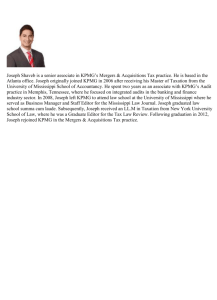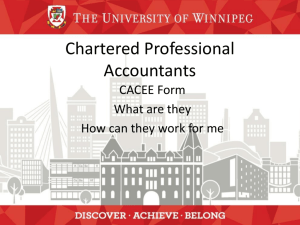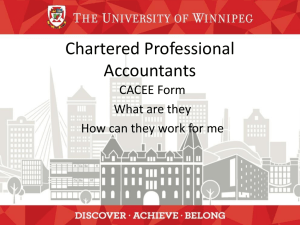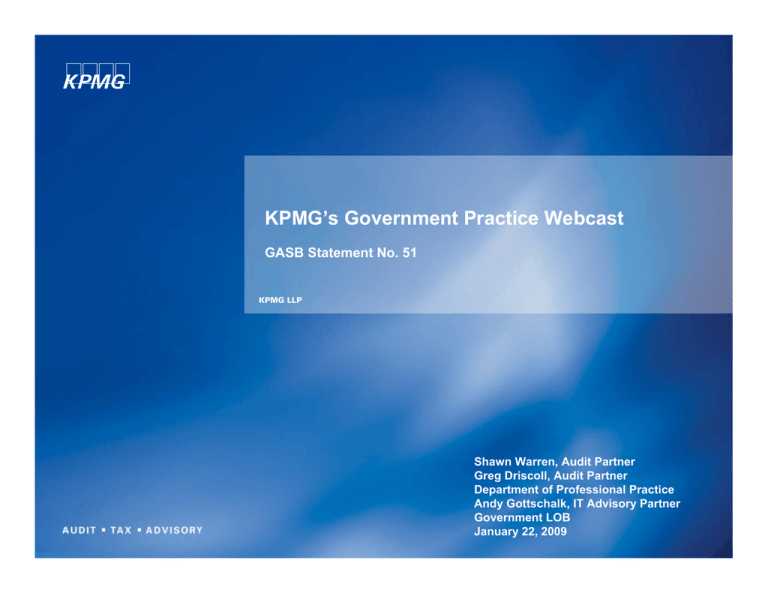
KPMG’s Government Practice Webcast
GASB Statement No. 51
KPMG LLP
Shawn Warren, Audit Partner
Greg Driscoll, Audit Partner
Department of Professional Practice
Andy Gottschalk, IT Advisory Partner
Government LOB
January 22, 2009
GASB Statement No. 51 Accounting
and Financial Reporting for Intangible
Assets
Welcome and Introduction
Shawn Warren, Audit Partner, KPMG LLP
© 2009 KPMG LLP, a U.S. limited liability partnership and a member firm of the KPMG network of
independent member firms affiliated with KPMG International, a Swiss cooperative. All rights reserved.
1
CPE Credit Requirements
z
To receive CPE credit, participants must be individually logged on
and must respond to at least 3 of the 5 “pop-up” questions during
the Webcast:
― Polling questions will appear in lower left corner of screen
― Do not view the presentation in “Enlarge Slide” as this option will block out
the CPE questions
― Hit “Submit” button in pop-up window after answering each CPE question
z
Use the “ask question” bar on your screen to ask questions of our presenters
z
Webcast Help Desk: 1-866-956-4770 (Outside the U.S. 601-957-5017)
Please note that CPE credit cannot be given to individuals who:
z
Attend in a group conference call unless they are logged in themselves
z
Listen to the archived playback only
© 2009 KPMG LLP, a U.S. limited liability partnership and a member firm of the KPMG network of
independent member firms affiliated with KPMG International, a Swiss cooperative. All rights reserved.
2
Today’s Guest Speakers
z
Shawn Warren
― Audit Partner, KPMG’s Government Practice
z
Greg Driscoll
― Audit Partner, KPMG’s Department of Professional Practice
z
Andy Gottschalk
― IT Advisory Partner, KPMG’s Government Practice
© 2009 KPMG LLP, a U.S. limited liability partnership and a member firm of the KPMG network of
independent member firms affiliated with KPMG International, a Swiss cooperative. All rights reserved.
3
Agenda
z
GASB Statement No. 51 Technical Discussion, Greg Driscoll
z
Comments on Internally Generated Computer Software, Andy Gottschalk
z
Q&A
© 2009 KPMG LLP, a U.S. limited liability partnership and a member firm of the KPMG network of
independent member firms affiliated with KPMG International, a Swiss cooperative. All rights reserved.
4
Background
z
Project born out of questions raised over description of capital assets in
Statement 34:
― “capital assets includes land, easements, buildings…and all other tangible
and intangible assets that are used in operations and that have initial useful
lives extending beyond a single reporting period”
z
Uncertainty in practice as to what was meant by intangible assets in the
description
z
Statement 51 issued in June 2007 to reduce inconsistencies in financial reporting
z
Statement 51 effective for periods beginning after June 15, 2009
© 2009 KPMG LLP, a U.S. limited liability partnership and a member firm of the KPMG network of
independent member firms affiliated with KPMG International, a Swiss cooperative. All rights reserved.
5
Overview
z
Statement 51 addresses the following aspects of reporting intangible assets:
― Description
― Classification
― Recognition
z
General recognition requirement
z
Broad approach to recognizing internally generated intangible assets
z
Specific approach to recognizing internally generated computer software
― Measurement
z
Initial measurement
z
Amortization
― Impairment
― Disclosures
― Transition provisions
© 2009 KPMG LLP, a U.S. limited liability partnership and a member firm of the KPMG network of
independent member firms affiliated with KPMG International, a Swiss cooperative. All rights reserved.
6
Description
z
An intangible asset is an asset that possesses all of the following characteristics:
― Lack of physical substance
― Nonfinancial nature
― Initial useful life extending beyond a single reporting period
z
Statement generally does not provide guidance on whether a transaction results
in an asset
― Look to definition of “asset” in Concepts Statement No. 4, Elements of
Financial Statements for guidance
― Basis for conclusions does state that powers created through statute or
inherent nature of government are not intangible assets
© 2009 KPMG LLP, a U.S. limited liability partnership and a member firm of the KPMG network of
independent member firms affiliated with KPMG International, a Swiss cooperative. All rights reserved.
7
Common Types of Intangible Assets
z
Right-of-way easements
z
Other types of easements
z
Patents, copyrights, trademarks
z
Land use rights
z
Licenses and permits
z
Computer software
― Purchased or licensed
― Internally generated
― Websites
© 2009 KPMG LLP, a U.S. limited liability partnership and a member firm of the KPMG network of
independent member firms affiliated with KPMG International, a Swiss cooperative. All rights reserved.
8
Classification—Basic Guidance
z
All intangible assets subject to Statement 51 should be classified as capital
assets:
― All existing authoritative guidance related to capital assets should be applied
to these intangible assets
― Since considered capital assets, not reported as assets in governmental
fund financial statements
z
Scope exceptions:
― Intangible assets acquired or created primarily for directly obtaining income
or profit
― Capital leases
― Goodwill from a combination transaction
© 2009 KPMG LLP, a U.S. limited liability partnership and a member firm of the KPMG network of
independent member firms affiliated with KPMG International, a Swiss cooperative. All rights reserved.
9
Recognition
z
An intangible asset should be recognized only if it is identifiable:
― Asset is separable, i.e. capable of being separated and sold, transferred,
licensed, etc.
-OR― Asset arises from contractual or other legal rights, regardless of whether
rights are separable
© 2009 KPMG LLP, a U.S. limited liability partnership and a member firm of the KPMG network of
independent member firms affiliated with KPMG International, a Swiss cooperative. All rights reserved.
10
Internally Generated Intangible Assets
z
Internally generated intangible assets (IGIA) are:
― Created or produced by the government or an entity contracted by the
government; or
― Acquired from a third party but require more than minimal incremental effort
to achieve expected service capacity
z
Statement provides a specified-conditions approach to recognizing outlays
associated with IGIA
z
Guidance may result in capitalization of certain R&D costs previously expensed
under FASB Statement No. 2
© 2009 KPMG LLP, a U.S. limited liability partnership and a member firm of the KPMG network of
independent member firms affiliated with KPMG International, a Swiss cooperative. All rights reserved.
11
Internally Generated Intangible Assets
z
Outlays incurred related to an IGIA that is considered identifiable should be
capitalized only upon the occurrence of ALL of the following:
― Determination of the specific objective of the project and the nature of the
service capacity that is expected to be provided by the asset upon
completion of the project;
― Demonstration of the technical or technological feasibility for completing the
project so that the asset will provide its expected service capacity;
― Demonstration of the current intention, ability, and presence of effort to
complete or, in the case of a multiyear project, continue development of the
intangible asset
z
Outlays incurred prior to meeting the criteria should be expensed as incurred—no
“recycling” of expenses
© 2009 KPMG LLP, a U.S. limited liability partnership and a member firm of the KPMG network of
independent member firms affiliated with KPMG International, a Swiss cooperative. All rights reserved.
12
Internally Generated Computer Software
z
Specific guidance on applying the IGIA specified-conditions approach for
internally generated computer software (IGCS) is provided
z
IGCS is either:
― Developed in-house by government personnel or a contractor on their
behalf; or
― Commercially available software modified using more than minimal
incremental effort before being put in operation
z
Guidance based on development stages similar to AICPA SOP 98-1
© 2009 KPMG LLP, a U.S. limited liability partnership and a member firm of the KPMG network of
independent member firms affiliated with KPMG International, a Swiss cooperative. All rights reserved.
13
Internally Generated Computer Software
z
Activities associated with developing IGCS should be categorized in one of three
development stages:
― Preliminary project stage
z
Conceptual formulation and evaluation of alternatives
z
Determination of existence of needed technology
z
Final selection of alternatives
― Application development stage
z
Design of the chosen path
z
Coding
z
Installation to hardware
z
Testing and parallel processing
― Post-implementation/operation stage
z
Application user training
z
Software maintenance
© 2009 KPMG LLP, a U.S. limited liability partnership and a member firm of the KPMG network of
independent member firms affiliated with KPMG International, a Swiss cooperative. All rights reserved.
14
Internally Generated Computer Software
z
IGIA specified-conditions criteria are considered met for IGCS when:
― The activities in the preliminary project stage are completed
― Management authorizes and commits to funding the project
z
For commercially available software that is IGCS, these criteria are generally
considered met upon the government’s commitment to purchase or license
software
© 2009 KPMG LLP, a U.S. limited liability partnership and a member firm of the KPMG network of
independent member firms affiliated with KPMG International, a Swiss cooperative. All rights reserved.
15
Internally Generated Computer Software
z
Reporting of activity outlays:
― Preliminary project stage—expense as incurred
― Application development stage—capitalize once criteria is met; cease
capitalizing when software is operational
― Post-implementation/operation stage—expense as incurred
z
Reporting should be based upon nature of activity, not timing of its occurrence
z
No specific guidance on the types of outlays that can be capitalized (e.g. direct
costs vs. indirect costs)
© 2009 KPMG LLP, a U.S. limited liability partnership and a member firm of the KPMG network of
independent member firms affiliated with KPMG International, a Swiss cooperative. All rights reserved.
16
Internally Generated Computer Software
z
Data conversion activities may include:
― Purging/cleansing of existing data
― Conversion of data from legacy system to new system
― Reconciliation of data from legacy system and data in new system
z
Data conversion should be considered activity of the application development
stage only if necessary to make software operational—otherwise postimplementation/ operation stage
z
Consider human resources system vs. vendor information database
z
Statement 51 provision differs from SOP 98-1
― Notion of ancillary charges for capital assets
© 2009 KPMG LLP, a U.S. limited liability partnership and a member firm of the KPMG network of
independent member firms affiliated with KPMG International, a Swiss cooperative. All rights reserved.
17
Internally Generated Computer Software
z
Reporting costs of internally generated modifications of software already in
operation should follow the development stage approach if the modification
results in:
― An increase in the functionality of the software
― An increase in the efficiency of the software; or
― An extension of the estimated useful life of the software
z
If modification does not result in one of the above, associated outlays should be
expensed as incurred as maintenance
z
Extension of useful life without increased functionality or efficiency expected to
rarely occur
© 2009 KPMG LLP, a U.S. limited liability partnership and a member firm of the KPMG network of
independent member firms affiliated with KPMG International, a Swiss cooperative. All rights reserved.
18
Internally Generated Computer Software Costs
Practical Considerations
z
Need a policy
― Do costs need to be captured
― When to capitalize
― What costs to capture
z
Payroll costs
z
How to determine and track
© 2009 KPMG LLP, a U.S. limited liability partnership and a member firm of the KPMG network of
independent member firms affiliated with KPMG International, a Swiss cooperative. All rights reserved.
19
Internally Generated Computer Software Costs
Practical Considerations
z
Amortization period
z
Timing – when to begin amortization
z
The Department of Health and Human Services has issued guidance on
submitting for reimbursement:
― For those software costs capitalized; costs should be charged to the federal
program when the amortization of the capitalized costs is incurred.
© 2009 KPMG LLP, a U.S. limited liability partnership and a member firm of the KPMG network of
independent member firms affiliated with KPMG International, a Swiss cooperative. All rights reserved.
20
Internally Generated Computer Software Costs
Practical Considerations
z
Costs for the phases will need to be tracked
z
Data conversion cost
― To make operational
― Otherwise post implementation
© 2009 KPMG LLP, a U.S. limited liability partnership and a member firm of the KPMG network of
independent member firms affiliated with KPMG International, a Swiss cooperative. All rights reserved.
21
Measurement
z
Intangible assets follow measurement guidance for capital assets:
― Historical cost
― If donated, estimated fair value at date of donation
z
BFC provides Board’s non-authoritative views as to determining fair value of
donated right-of-way easements for roadways
z
Intangible assets excluded from scope because acquired or created to generate
income or profit generally should follow guidance for investments
© 2009 KPMG LLP, a U.S. limited liability partnership and a member firm of the KPMG network of
independent member firms affiliated with KPMG International, a Swiss cooperative. All rights reserved.
22
Amortization
z
Existing guidance for depreciation of capital assets generally applies to
amortizing intangible assets
― No mandated maximum amortization period
z
Exception for intangible assets with indefinite useful lives:
― No factors currently exist that limit the useful life of the asset
― A useful life that must be estimated does not mean indefinite useful life
z
Permanent right-of-way easement vs. computer software
― Intangible assets with indefinite useful lives should not be amortized
© 2009 KPMG LLP, a U.S. limited liability partnership and a member firm of the KPMG network of
independent member firms affiliated with KPMG International, a Swiss cooperative. All rights reserved.
23
Amortization
z
Useful life of an intangible asset that arises from contractual or legal rights should
not exceed the legal term of the rights
z
Renewal periods can be considered if there is evidence that:
― Renewal will be sought and will be able to be achieved, considering any
third-party consent; and
― Any anticipated outlays related to renewal are nominal in relation to the level
of service capacity expected to be obtained through the renewal
© 2009 KPMG LLP, a U.S. limited liability partnership and a member firm of the KPMG network of
independent member firms affiliated with KPMG International, a Swiss cooperative. All rights reserved.
24
Impairment
z
The provisions of Statement 42, Accounting and Financial Reporting for
Impairment of Capital Assets and for Insurance Recoveries, generally should be
applied to determine impairment of intangible assets
z
“Development stoppage” added to the impairment indicators in Statement 42
z
An implementation guide question details examples of circumstances that may
indicate impairment
© 2009 KPMG LLP, a U.S. limited liability partnership and a member firm of the KPMG network of
independent member firms affiliated with KPMG International, a Swiss cooperative. All rights reserved.
25
Note Disclosures
z
No note disclosure requirements specific to intangible assets
z
Intangible assets should be incorporated into the capital asset note disclosures
z
An implementation guide question discusses inclusion of intangible assets in
major classes of capital assets
© 2009 KPMG LLP, a U.S. limited liability partnership and a member firm of the KPMG network of
independent member firms affiliated with KPMG International, a Swiss cooperative. All rights reserved.
26
Effective Date and Transition
z
Effective date is fiscal periods beginning after June 15, 2009
z
Provisions generally should be retroactively applied
z
Exceptions for retroactively reporting intangible assets:
― Permitted but not required for IGIA to the extent specified-conditions
approach can be applied
― Permitted but not required for intangible assets with indefinite useful lives at
transition
― Required for all other intangible assets acquired in fiscal years ending after
June 30, 1980 by phase 1 or 2 governments
― Encouraged but not required for all other intangible assets of phase 3
governments
© 2009 KPMG LLP, a U.S. limited liability partnership and a member firm of the KPMG network of
independent member firms affiliated with KPMG International, a Swiss cooperative. All rights reserved.
27
Effective Date and Transition
z
Indefinite useful life provisions should be applied retroactively only if asset has
indefinite useful life at transition
z
Land use rights associated with property already owned by government should
not be reported as intangible assets separate from the property
z
Additional Statement 51 implementation guidance is included in the 2008
Comprehensive Implementation Guide
© 2009 KPMG LLP, a U.S. limited liability partnership and a member firm of the KPMG network of
independent member firms affiliated with KPMG International, a Swiss cooperative. All rights reserved.
28
Q&A
All information provided is of a general nature and is not intended to address the circumstances of any particular individual or entity.
Although we endeavor to provide accurate and timely information, there can be no guarantee that such information is accurate as of the
date it is received or that it will continue to be accurate in the future. No one should act upon such information without appropriate
professional advice after a thorough examination of the particular situation.
© 2009 KPMG LLP, a U.S. limited liability partnership and a member firm of the KPMG network of
independent member firms affiliated with KPMG International, a Swiss cooperative. All rights reserved.
29
Closing Items
z
Provided that you were eligible for CPE credit, you will receive the certificate
electronically in 4 – 6 weeks.
z
Replay of this webcast is available, and instructions will be sent to you
electronically.
z
We value your opinion! Please complete and return the evaluation form for
today’s webcast. The form is available in the “Downloadable Files” section (lower
right corner) of the webcast player.
THANK YOU FOR JOINING
KPMG’s GASB STATEMENT NO. 51 WEBCAST
© 2009 KPMG LLP, a U.S. limited liability partnership and a member firm of the KPMG network of
independent member firms affiliated with KPMG International, a Swiss cooperative. All rights reserved.
30
For more information on this presentation, please contact:
Shawn Warren
Audit Partner
KPMG LLP
Tel: 617-988-1056
swarren@kpmg.com
© 2009 KPMG LLP, a U.S. limited liability partnership and a member firm of the KPMG network of
independent member firms affiliated with KPMG International, a Swiss cooperative. All rights reserved.
31

